Cool Science
The Problem
At noon on a clear summer day in the United States, a flat (horizontal) surface receives about 1000 watts of sunlight per square meter. (This is about 100 watts, or the power of a bright incandescent light bulb, per square foot.) Traditional dark roofs strongly absorb this sunlight, heating both the building and the surrounding air. This increases energy use in air conditioned buildings, and makes non-air conditioned buildings less comfortable. Hot dark roofs also aggravate urban heat islands by warming the air flowing over the roof, and contribute to global warming by radiating heat into the atmosphere.
Cool Roofs
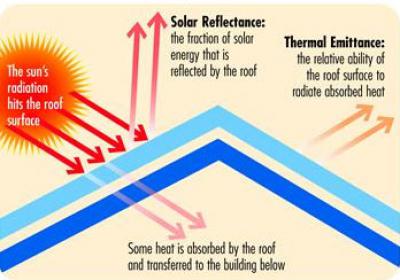
Definition
On a sunny day, a roof that strongly reflects sunlight can stay much cooler than a roof that strongly absorbs sunlight. High thermal emittance is another property that also keeps a surface cool. Thermal emittance is the efficiency with which a surface cools itself by emitting thermal (or "far") infrared radiation. Thus a "cool" roof should have both high solar reflectance (SR) and high thermal emittance (TE).
We note that since the spectrum of thermal radiation (4-80 microns) does not overlap with that of solar radiation (0.3-2.5 microns), thermal emittance is independent of solar reflectance. Thus, we distinguish between the two when defining a cool roof.
BENEFITS
Substituting a cool roof for a warm roof reduces conduction of heat into the building, convection of heat into the outside air, and thermal radiation of heat into the atmosphere. This benefits our buildings, our cities, and our planet.
- Cooler outside air. Cool roofs lower urban air temperatures by reducing the amount of heat transferred from roofs to the air, mitigating the urban heat island effect.
- Fewer power plant emissions. Reflective roofs reduce cooling energy demand in air conditioned buildings, decreasing emissions of greenhouse gases and other air pollutants at power plants that burn fossil fuels.
- Better air quality. Cool roofs decrease urban air temperatures and thus slow the formation of ground level ozone. Ozone, the primary component of smog, can aggravate respiratory illness and can act as a greenhouse gas.
- Slowed climate change. Cool roofs decrease heat absorbed at the Earth's surface and thus can lower surface temperatures. This decrease in surface temperatures reduces the flow of heat into the atmosphere, offsetting warming caused by greenhouse gases.
- Energy and cost savings. During hot summer months, cool roofs reduce the need for cooling in air conditioned buildings, which saves energy and money.
- Reduced electrical grid strain. The diminished demand for cooling energy will also moderate peak energy demand during heat waves and very hot summer afternoons, thereby decreasing the risk of power outages.
- Improved indoor comfort. Cool roofs lower the indoor air temperature in buildings that do not have air conditioning, promoting productivity and occupant health.

PENALTIES
Cool roofs may also have some undesirable effects.
- Increased need for heating in winter. During winter months, cool roofs increase the need for heating energy in cold climates. However, in winter the sun stays low, the days are short, and the skies are often cloudy, limiting the amount of sunlight available to a roof. A study conducted by the Heat Island Group shows that in the United States, this winter heating penalty is typically small compared to the summer cooling benefit (see image at right).2 (Additionally, note that if a roof is covered with snow, the color of the roofing product doesn't matter — the roof's surface will be white.)
- Glare. Glare from a bright white or silvery roof on a low-rise building may disturb occupants of taller neighboring buildings. In this situation a cool-colored (nonwhite) roof may be more appropriate for the shorter building.
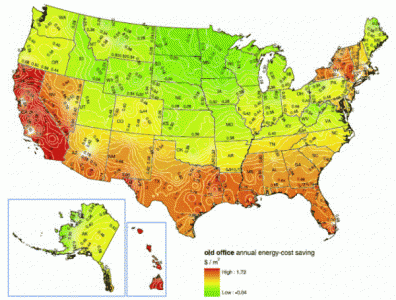
Notes:
2 Levinson R, Akbari H. 2010. Potential benefits of cool roofs on commercial buildings: conserving energy, saving money, and reducing emission of greenhouse gases and air pollutants. Energy Efficiency. 3:53-109.
THE SCIENCE OF COOL
Sunshine includes ultraviolet, visible, and near-infrared light. Only visible light affects color. About half of the sun's energy is invisible near-infrared light. Traditional dark roofs strongly absorb ultraviolet, visible, and near-infrared light. Cool-colored dark roofs look like traditional dark roofs but better reflect near-infrared light.
On a typical summer afternoon, a cool-colored roof that reflects 35% of sunlight will stay about 12°C (22°F) cooler than a traditional roof that looks the same but reflects only 10% of sunlight.
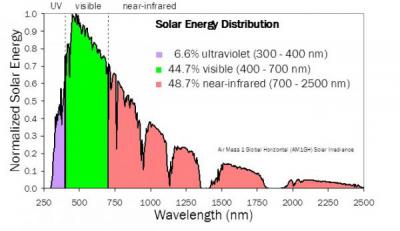
TECHNOLOGY
White Roofs
White materials are a popular cool option for building surfaces that cannot be seen from the street, such as low-sloped "flat" (that is, nearly horizontal) roofs. In some parts of the world pitched roofs may also be white. Roofing products available in white include single-ply membrane, elastomeric coating, painted metal, tile, and ballast.
On a typical summer afternoon, a clean white roof that reflects 80% of sunlight will stay about 31°C (55°F) cooler than a gray roof that reflects only 20% of sunlight.3
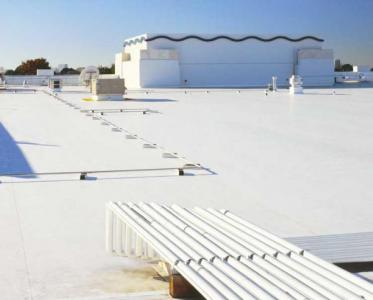
Cool-Colored Roofs
Cool-colored roofs are designed to increase reflection of sunshine while maintaining the color and aesthetic of traditional nonwhite roofing products. Over the past decade, researchers at Lawrence Berkeley National Laboratory and Oak Ridge National Laboratory have worked with roofing manufacturers to create a variety of cool-colored products for pitched roofs. These include asphalt shingle, metal, tile, and ballast products. Cool color technology can also be used to create nonwhite materials for low-sloped roofs, such as membranes and coatings.

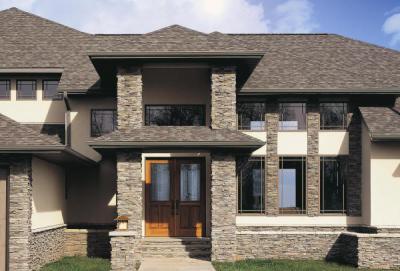
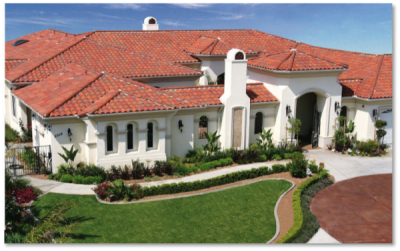
Notes:
3 Calculated under the standard summer afternoon weather specified in ASTM Standard E1980-11, using the medium wind speed condition.
Related Links:
RELATED PUBLICATIONS
2019
Gilbert, Haley E, Tom Jacobs, Seongeun Jeong, Melvin Pomerantz, Dev Millstein, Doug Norsby, Andrea Repinsky, and Ronnen M Levinson. Heat Island Mitigation Assessment and Policy Development for the Kansas City Region. 2019.
![]() PDF (4.17 MB)
PDF (4.17 MB)
2018
Chen, Sharon S, Hugo Destaillats, Jing Ge, and Ronnen M Levinson. Calibration of laboratory aging practice to replicate changes to roof albedo in a Chinese city. 2018. LBNL-2001005.
![]() PDF (3.98 MB)
PDF (3.98 MB)
2015
Sleiman, Mohamad, Sharon S Chen, Haley E Gilbert, Thomas W Kirchstetter, Paul H Berdahl, Erica Bibian, Laura S Bruckman, Dominic Cremona, Roger H French, Devin A Gordon, Marco Emiliani, Justin Kable, Liyan Ma, Milena Martarelli, Riccardo Paolini, Matthew Prestia, John Renowden, Gian Marco Revel, Olivier Rosseler, Ming Shiao, Giancarolo Terraneo, Tammy Yang, Lingtao Yu, Michele Zinzi, Hashem Akbari, Ronnen M Levinson, and Hugo Destaillats. "Soiling of building envelope surfaces and its effect on solar reflectance – Part III: Interlaboratory study of an accelerated aging method for roofing materials." Solar Energy Materials and Solar Cells 143 (2015) 581-590.
2014
Gao, Yafeng, Jiangmin Xu, Shichao Yang, Xiaomin Tang, Quan Zhou, Jing Ge, Tengfang T Xu, and Ronnen M Levinson. "Cool Roofs in China: Policy Review, Building Simulations, and Proof-Of-Concept Experiments." Energy Policy 74 (2014) 190-214.
Sleiman, Mohamad, Thomas W Kirchstetter, Paul H Berdahl, Haley E Gilbert, Sarah Quelen, Lea Marlot, Chelsea V Preble, Sharon S Chen, Amandine Montalbano, Olivier Rosseler, Hashem Akbari, Ronnen M Levinson, and Hugo Destaillats. "Soiling of building envelope surfaces and its effect on solar reflectance – Part II: Development of an accelerated aging method for roofing materials." Solar Energy Materials and Solar Cells 122 (2014) 271-281. LBNL-6714E.
![]() PDF (891.77 KB)
PDF (891.77 KB)
2013
Rossi, Federico, Franco Cotana, Mirko Filipponi, Andrea Nicolini, Surabi Menon, and Arthur H Rosenfeld. "Cool roofs as a strategy to tackle global warming: economical and technical opportunities." Advances in Building Energy Research 7.2 (2013) 254 - 268.
2010
Levinson, Ronnen M, Hashem Akbari, Paul H Berdahl, Kurt Wood, Wayne Skilton, and Jerry Petersheim. "A novel technique for the production of cool colored concrete tile and asphalt shingle roofing products." Solar Energy Materials and Solar Cells 94.6 (2010) 946-954.
2008
Akbari, Hashem, and Ronnen M Levinson. "Evolution of cool roof standards in the United States." Advances in Building Energy Research 2.1 (2008) 1-32. LBNL-736E.
Akbari, Hashem, Ronnen M Levinson, and Stephanie Stern. "Procedure for measuring the solar reflectance of flat or curved roofing assemblies." Solar Energy 82.7 (2008) 648-655.
Wray, Craig P, and Hashem Akbari. "The effects of roof reflectance on air temperatures surrounding a rooftop condensing unit." Energy and Buildings 40.1 (2008) 11-28.
Akbari, Hashem, and Leanna S Rose. "Urban Surfaces and Heat Island Mitigation Potentials." Journal of the Human-Environmental System 11.2 (2008) 85-101.
2005
Akbari, Hashem, Ronnen M Levinson, and Leo I Rainer. "Monitoring the energy-use effects of cool roofs on California commercial buildings." Energy and Buildings 37.10 (2005) 1007-1016.
Levinson, Ronnen M, Paul H Berdahl, and Hashem Akbari. "Solar spectral optical properties of pigments—Part I: model for deriving scattering and absorption coefficients from transmittance and reflectance measurements." Solar Energy Materials and Solar Cells 89.4 (2005) 319-349.
Levinson, Ronnen M, Paul H Berdahl, and Hashem Akbari. "Solar spectral optical properties of pigments—Part II: survey of common colorants." Solar Energy Materials and Solar Cells 89.4 (2005) 351-389.
1998
Akbari, Hashem, and Steven J Konopacki. "The impact of reflectivity and emissivity of roofs on building cooling and heating energy use." Proceedings of Thermal VII: Thermal Performance of the Exterior Envelopes of Buildings VII 1998.
1995
Rosenfeld, Arthur H, Hashem Akbari, Sarah E Bretz, Beth L Fishman, Dan M Kurn, David J Sailor, and Haider Taha. "Mitigation of urban heat islands: materials, utility programs, updates." Energy and Buildings 22.3 (1995) 255-265.